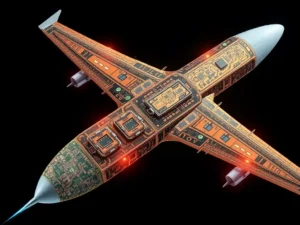Tough conditions are common for spacecraft. Therefore, you have to make sure the components used for spacecraft can handle such situations. The spacecraft electronics are no exception. Consequently, the aerospace PCB must work with high precision and reliability.
One of the biggest problems for circuit boards in space is vibration. When a spacecraft launches, the rocket engine creates strong vibrations and noise. On the other hand, turbulence is a common phenomenon in aircraft. These vibrations can damage or fail an aerospace PCB and its assembly. To resolve these problems, you must choose a reliable aerospace PCB manufacturer accordingly.
Common Types of Vibrations in Spacecraft
Many types of vibrations can affect aircraft. Rocket noise is the first one. When a rocket engine ignites, it produces a loud sound. The sound waves reflect as acoustic waves, which shake the launch pad and the spacecraft. This noise can damage sensitive electronics.
Another common type of vibration is aerodynamic excitation. During high-speed flights, different airflow patterns occur around the spacecraft. These airflow patterns often produce various levels of vibrations.
Shockwaves produced by these airflow patterns can move back and forth. In some situations, air can get trapped in cavities, creating pressure changes. Sometimes, the air flows separately and reattaches, which produces even more shaking. Besides, the vehicle can vibrate by itself if the airflow becomes unstable.
The spacecraft also faces a turbulent environment. You might already be familiar with this situation. It is a fast and irregular change in air or gas flow. The sudden effects of this cause constant movement and shaking of the aircraft.
These vibrations may vary from one mission to another. The type of rocket or airplane, the payload, and the project plan affect the vibrations.

How Vibrations Affect Aerospace PCB Assembly
Aerospace PCBs may suffer many types of damage from vibrations. The most common problem is losing the components on the PCB. If the intensity of the vibration is too high, the capacitors may break.
Solder joints, which hold parts together, can crack. Tracks on the board that carry the signal may break. The board itself can start to peel apart in a process called delamination.
Barrels, the walls inside holes on the PCB, may also break. There’s more. Pins inside the holes can also break. Metal may lead to the connection parts becoming weak due to repeated stress.
Vibrations may cause all of this damage. As a result, your aerospace PCB assembly may stop working, leading to serious problems. Since repairs are impossible in space, avoiding failure is very important here.
How to Protect Circuit Boards from Vibrations
Designing the board correctly is the key to ensuring the highest protection. You must also mount the components correctly. Ensure that you have placed each part securely on board. Analyze how you place these parts to ensure everything follows the proper rules.
You can also use glue or sealants during the PCB assembly. These materials help absorb shocks and reduce the movement of the parts when the board vibrates. However, to create strong connections, you must do the soldering perfectly.
Another good practice is to ensure that boards have smooth and firm edges. Shrinking the aerospace PCB may also help reduce vibration damage. You could also consider special enclosures. In this case, you can collect more information about how much vibration a board is experiencing.
Anti-vibration frames are another helpful solution. They are more expensive but extremely helpful in protecting sensitive electronics.
Mechanical waves can also travel through the board and damage it. To reduce this, you can place connectors near significant components. This helps stop the waves before they spread too much.
Why Aerospace PCB Assembly Reliability is Critical in Space Missions?
Electronic systems in spacecraft must be reliable. A single mistake can lead to big problems. Once in space, no one can repair them unless they land on Earth or at a space station. A problem with a PCB board or in its assembly can cause the entire system to fail. Electronics must work for many years in long missions, such as satellite operations. That is why you must perform rigorous testing before launch.
Aerospace PCB Design Rules to Reduce Vibration Damage
There are particular steps for making space-grade PCBs. The process may involve considering various factors. Considerations such as circuit arrangement, heat management, and PCB pressure tolerance are crucial.
#1 Derating
One of the critical rules is called derating. This is a specialized process that runs parts below their standard limit. For example, the electric current in the circuit is decreased by 66%. This way, you can typically prevent overheating. In space, there is no air to carry heat away, so you must only remove the heat by conduction or radiation.
#2 Flight Model Boards
Flight Model (FM) boards have strict design needs. They must use certain types of holes. Through-holes and buried vias are allowed, but blind vias are not. FM boards cannot have variable components like trimmer capacitors or adjustable resistors. Only fixed-value parts are used.
#5 Conductor Design
You must design the conductors carefully. They can pull heat away from the solder pad if connected to an internal power plane. This is called a cold solder joint, a type of bad connection. To prevent this, ensure the conductor width and length are 1mm each. In this case, pay attention to the ratio of 1.5:1.
#6 Symmetrical Board Design
Aerospace PCB design and assembly must be symmetrical. You must ensure that the copper layers and the components are correctly balanced. This way, you can ensure the PCB does not twist or bend.
#7 Plated Through Holes (PTHs)
Plated-through holes (PTHs) are the only accepted holes. Other items like standoffs, rivets, or eyelets are not allowed.
#8 Special Solder Maks and Lamination
When manufacturing airborne PCBs, solder masks are skipped. In space, solder masks might peel away or release gases. It might affect the performance or the parts fall.
For aerospace PCB design standards and assembly, you can consider copper-clad lamination. The layers do not usually separate and stick to each other well. A conformal coating can help protect your PCB from ESD. The term ESD in this case refers to Electrostatic Discharge. The thin layers prevent the charge from gathering and releasing all at once.
#9 PCB Assembly Standards
Make sure the patterns on the surface are large enough. Little details can fall off or come loose. The width of conductors should be at least 0.1 mm.
If it is vital, have the connection go through the same layer. You can also include an additional path and more vias if space does not permit the first option. There are many ways to prevent only one element from failing.
In general, make sure to inspect all the parts. Defects or false parts can greatly damage the aircraft. Reliability matters more in space electronics than in cost.
Conclusion
Extreme Vibrations and temperatures in space can seriously damage printed circuit boards. So, you should follow a proper manufacturing and assembly process for aerospace PCBs. Every detail matters in this process, from how parts are mounted to how heat is managed.
UETPCB is a leading manufacturer of high-quality PCB aerospace components. If you are interested in our PCB manufacturing and assembly services, feel free to contact us.

